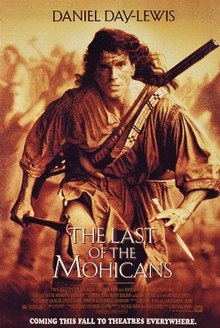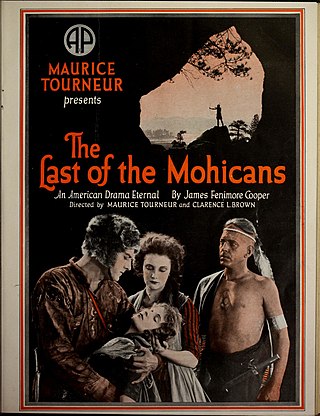
The Last of the Mohicans is a 1920 American silent adventure drama film written by Robert A. Dillon, adapted from James Fenimore Cooper's 1826 novel of the same name. Clarence Brown and Maurice Tourneur co-directed the film. It is a story of two English sisters meeting danger on the frontier of the American colonies, in and around the fort commanded by their father. The adventure film stars Wallace Beery, Barbara Bedford, Lillian Hall, Alan Roscoe and Boris Karloff in one of his earliest silent film roles. Barbara Bedford later married her co-star in the film, Alan Roscoe in real life. The production was shot near Big Bear Lake and in Yosemite Valley.
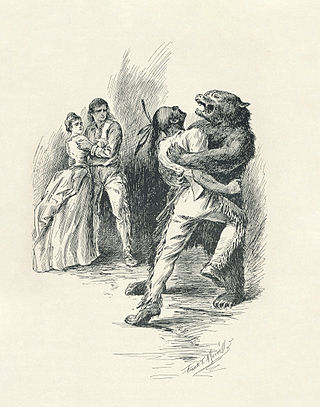
The Last of the Mohicans: A Narrative of 1757 is a historical romance novel written by James Fenimore Cooper in 1826. It is the second book of the Leatherstocking Tales pentalogy and the best known to contemporary audiences. The Pathfinder, published 14 years later in 1840, is its sequel; its prequel, The Deerslayer, was published a year after The Pathfinder. The Last of the Mohicans is set in 1757, during the French and Indian War, when France and Great Britain battled for control of North America. During this war, both the French and the British used Native American allies, but the French were particularly dependent, as they were outnumbered in the Northeast frontier areas by the British. Specifically, the events of the novel are set immediately before, during, and after the Siege of Fort William Henry.

Magua is a fictional character and the main antagonist in the 1826 novel The Last of the Mohicans by James Fenimore Cooper. This historical novel is set at the time of the French and Indian War. A Huron Indian chief, he is also known by the French alias "Le Renard Subtil".

The Leatherstocking Tales is a series of five novels by American writer James Fenimore Cooper, set in the eighteenth-century era of development in the primarily former Iroquois areas in central New York. Each novel features Natty Bumppo, a frontiersman known to European-American settlers as "Leatherstocking", "The Pathfinder", and "the trapper". Native Americans call him "Deerslayer", "La Longue Carabine", and "Hawkeye".

Chingachgook is a fictional character in four of James Fenimore Cooper's five Leatherstocking Tales, including his 1826 novel The Last of the Mohicans. Chingachgook was a lone Mohican chief and companion of the series' hero, Natty Bumppo. In The Deerslayer, Chingachgook married Wah-ta-Wah, who had a son with him named Uncas, but died while she was still young. Uncas, who was at his birth "last of the Mohicans", grew to manhood but was killed in a battle with the Huron warrior Magua. Chingachgook died as an old man in the novel The Pioneers, which makes him the actual "last of the Mohicans," having outlived his son.

The capture and rescue of Jemima Boone and the Callaway girls is a famous incident in the colonial history of Kentucky. Three girls were captured by a Cherokee-Shawnee raiding party on July 14, 1776, and rescued three days later by Daniel Boone and his party, celebrated for their success. The incident was portrayed in 19th-century literature and paintings: James Fenimore Cooper created a fictionalized version of the episode in his novel The Last of the Mohicans (1826) and Charles Ferdinand Wimar painted The Abduction of Boone's Daughter by the Indians.

Lieutenant-Colonel George Monro (1700–1757) was a Scots-Irish officer in the British Army. He is best remembered for his unsuccessful defense of Fort William Henry in 1757 during the French and Indian War. After surrendering with full honours of war to French General Louis-Joseph de Montcalm, he and his troops were attacked by France's Native allies. The events of the siege were made famous by James Fenimore Cooper in his novel The Last of the Mohicans.

The Deerslayer, or The First War-Path (1841) was James Fenimore Cooper's last novel in his Leatherstocking Tales. Its 1740–1745 time period makes it the first installment chronologically and in the lifetime of the hero of the Leatherstocking tales, Natty Bumppo. The novel's setting on Otsego Lake in central, upstate New York, is the same as that of The Pioneers, the first of the Leatherstocking Tales to be published (1823). The Deerslayer is considered to be the prequel to the rest of the series. Fenimore Cooper begins his work by relating the astonishing advance of civilization in New York State, which is the setting of four of his five Leatherstocking Tales.

The Last of the Mohicans is a 1932 American pre-Code Mascot movie serial based on the 1826 novel The Last of the Mohicans by James Fenimore Cooper.

The Last of the Mohicans is a 1936 American historical western adventure film directed by George B. Seitz and starring Randolph Scott, Binnie Barnes and Henry Wilcoxon. The screenplay by Philip Dunne was based on the 1826 novel of the same name by James Fenimore Cooper. It was produced by Edward Small and distributed by United Artists.
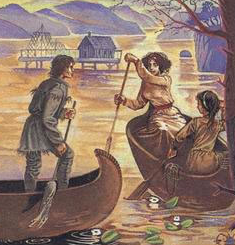
Nathaniel "Natty" Bumppo is a fictional character and the protagonist of James Fenimore Cooper's pentalogy of novels known as the Leatherstocking Tales.
The Deerslayer and Chingachgook is the feature-length first part of the two-part 1920 German silent Western film Lederstrumpf (Leatherstocking), directed by Arthur Wellin and featuring Bela Lugosi. It is based on the 1841 novel The Deerslayer by James Fenimore Cooper. The second part is called The Last of the Mohicans.
The Last of the Mohicans is the feature-length second part of the 1920 German silent Western film Lederstrumpf (Leatherstocking) directed by Arthur Wellin and featuring Bela Lugosi and Emil Mamalock. Bela Lugosi played the Indian Chingachgook, one of his most unusual roles, and Emil Mamalock played Hawkeye, the Deerslayer. It is based on James Fenimore Cooper's 1826 novel of the same name. The first part is The Deerslayer and Chingachgook.
The Last of the Mohicans is a 1971 BBC serial, based on the 1826 novel of the same name by James Fenimore Cooper, directed by David Maloney.
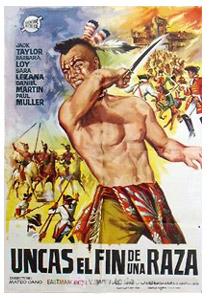
Fall of the Mohicans is a 1965 Spanish-Italian historical western adventure film directed by Mateo Cano and starring Jack Taylor, Paul Muller and Sara Lezana. The film is based on James Fenimore Cooper's 1826 novel The Last of the Mohicans, but made in the style of a Spaghetti Western. It was shot on location in the Tabernas Desert of Almería Another adaptation of the story The Last Tomahawk was released the same year by Germany's Constantin Film.
The Last of the Mohicans is a 1968 internationally co-produced Western film, co-directed by Jean Dréville, Pierre Gaspard-Huit and Sergiu Nicolaescu. It was the second episode of the European TV miniseries Leatherstocking Tales.

Last of the Redskins is a 1947 American Western film directed by George Sherman and starring Joh Hall and Michael O'Shea. The film was shot in Vitacolor but released in Cinecolor.
Last of the Mohicans is a 1977 American adventure drama television film based on the novel The Last of the Mohicans by James Fenimore Cooper. The film was directed by James L. Conway, written by Stephen Lord, and stars Steve Forrest, Ned Romero, Andrew Prine, Don Shanks, Michele Marsh, Jane Actman, and Robert Tessier. It was produced by Schick Sunn Classic Pictures as part of their Classics Illustrated series, and aired on NBC on November 23, 1977.

The Last Tomahawk or The Last of the Mohicans is a 1965 Western adventure film directed by Harald Reinl and starring Joachim Fuchsberger, Karin Dor and Marie France. It was a co-production between France, Spain and West Germany. It is loosely based on James Fenimore Cooper's 1826 novel The Last of the Mohicans, with the setting moved forward more than a century to the American West of the post-Civil War-era. Another version Fall of the Mohicans was made the same year.
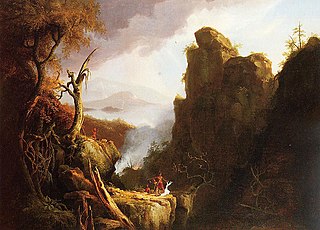
The Last of the Mohicans: The Death of Cora, also known as Indian Sacrifice, is a c. 1827 painting by British-American painter Thomas Cole, the founder of the Hudson River School. The painting depicts the death of Cora from the 1826 American novel The Last of the Mohicans. It is one of four such paintings by Cole which depict scenes from the novel. The painting is currently owned by the University of Pennsylvania.
